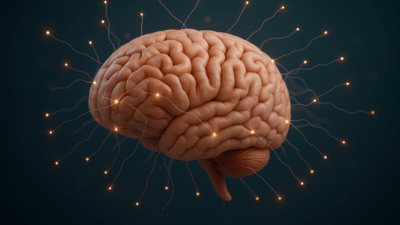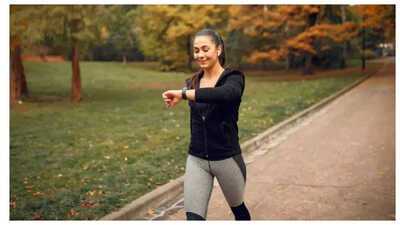Dementia is the leading cause of disability and dependency among older adults globally. In 2021, 57 million people had dementia worldwide, and every year, nearly 10 million new cases arise. While most of us believe keeping the brain sharp is key to preventing or reducing the risk of dementia, a leading neurosurgeon reveals that keeping the legs strong is crucial. Dr. Arun L. Naik, a neurosurgeon trained at All India Institute of Medical Sciences (AIIMS), India, explains that dementia starts in the leg! “Dementia may start in your legs, not your brain,” he said. Let’s take a look.
What is dementia?

Dementia is an umbrella term for several diseases that affect memory, thinking, and the ability to perform daily activities. It is a progressive neurological condition, which means it worsens with age and severely affects the quality of life.
Dementia starts in the leg

“Did you know dementia starts in your legs? Physical inactivity weakens your leg muscles, leading to sarcopenia, a loss of muscle mass. But here is the shocking part. Studies show that weak legs can speed up cognitive decline and increase dementia risk. Because active muscles pump out powerful chemicals that boost brain health. These chemicals are called brain-derived neurotrophic factors, BDNF, which increase connections in your memory area called the hippocampus. Strong legs mean strong balance and zero falls as you age. Falls are dangerous after the age of 65,” Dr. Naik said in a video shared on Instagram
The doctor pointed at a 2020 study published in Neurology, which found that slower walking speed in older adults was linked to smaller brain volume and a higher risk of cognitive decline. “Why? Because walking is not just a physical task, it’s a full-brain workout,” he added.
How walking protects the brain

Walking, which is one of the simplest forms of exercise, has many health benefits, including improved brain health. Speaking about the brain–leg connection, the neurosurgeon said, “Every step involves coordination between the frontal lobe, cerebellum, spinal cord, and proprioceptive feedback loops.”
Walking also boosts circulation. “Leg movement improves blood flow to the brain, delivering oxygen, glucose, and clearing out toxins,” Dr. Naik said.
Video
“Gait Changes = Brain Warning. Changes in walking style, balance, or pace often precede memory symptoms by years,” he added.
The doctor added that walking is neuroplasticity in motion. “Walking stimulates BDNF (Brain-Derived Neurotrophic Factor), which strengthens neuron connections,” he said.
How prevent dementia and protect your brain?

Dr. Naik also shared effective strategies that can prevent dementia through movement and improve brain health.
Along with movement, the doctor recommends eating protein-rich food to maintain muscle mass.
The neurosurgeon also emphasized that it is never too late. “Studies have shown that it's never too late to start. Starting even at 60s have shown to reduce dementia by a mile. Remember, strong legs, sharp brain. Don't wait till sarcopenia hits your brain. Start in your 40s.”
Keeping your legs active isn’t just about mobility—it’s one of the most powerful ways to protect your brain and reduce the risk of dementia as you age.
What is dementia?
Dementia is an umbrella term for several diseases that affect memory, thinking, and the ability to perform daily activities. It is a progressive neurological condition, which means it worsens with age and severely affects the quality of life.
Dementia starts in the leg
“Did you know dementia starts in your legs? Physical inactivity weakens your leg muscles, leading to sarcopenia, a loss of muscle mass. But here is the shocking part. Studies show that weak legs can speed up cognitive decline and increase dementia risk. Because active muscles pump out powerful chemicals that boost brain health. These chemicals are called brain-derived neurotrophic factors, BDNF, which increase connections in your memory area called the hippocampus. Strong legs mean strong balance and zero falls as you age. Falls are dangerous after the age of 65,” Dr. Naik said in a video shared on Instagram
The doctor pointed at a 2020 study published in Neurology, which found that slower walking speed in older adults was linked to smaller brain volume and a higher risk of cognitive decline. “Why? Because walking is not just a physical task, it’s a full-brain workout,” he added.
How walking protects the brain
Walking, which is one of the simplest forms of exercise, has many health benefits, including improved brain health. Speaking about the brain–leg connection, the neurosurgeon said, “Every step involves coordination between the frontal lobe, cerebellum, spinal cord, and proprioceptive feedback loops.”
Walking also boosts circulation. “Leg movement improves blood flow to the brain, delivering oxygen, glucose, and clearing out toxins,” Dr. Naik said.
Video
“Gait Changes = Brain Warning. Changes in walking style, balance, or pace often precede memory symptoms by years,” he added.
The doctor added that walking is neuroplasticity in motion. “Walking stimulates BDNF (Brain-Derived Neurotrophic Factor), which strengthens neuron connections,” he said.
How prevent dementia and protect your brain?

Dr. Naik also shared effective strategies that can prevent dementia through movement and improve brain health.
- Daily walk: Walk 30 minutes daily at a brisk pace.
- Add balance exercises like tandem walking and single-leg stands.
- Practice dual-task walking (e.g., walking while talking or solving a simple mental task).
- Include strength training for lower limbs, muscle is cognitive insurance.
- Avoid long periods of sitting; movement every hour keeps memory sharp.
Along with movement, the doctor recommends eating protein-rich food to maintain muscle mass.
The neurosurgeon also emphasized that it is never too late. “Studies have shown that it's never too late to start. Starting even at 60s have shown to reduce dementia by a mile. Remember, strong legs, sharp brain. Don't wait till sarcopenia hits your brain. Start in your 40s.”
Keeping your legs active isn’t just about mobility—it’s one of the most powerful ways to protect your brain and reduce the risk of dementia as you age.
You may also like

James Comey trial: Ex-FBI director pleads not guilty in court; calls it 'vindictive, selective prosecution'

Nigel Farage earns over £1 million from 'second jobs' - check your MP's earnings

Big Brother star George breaks silence after show axe over 'unacceptable behaviour'

Copy Claudia Winkleman with these Traitors-inspired fashion finds from the high street

EastEnders fans 'will get answers soon' as dark storyline 'ramps up'







